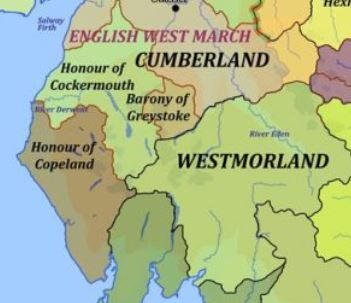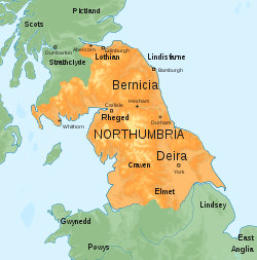
© Former Crown Manor of Ennerdale
Feudal Barony of Copeland





More about Cumbria - Copeland
and Ennerdale
Ancient Scottish Feudal Barony
and former “Crown Manor” of
Ennerdale
Baron Copeland - Or Barons of Copeland -
Coupland Couplandia Baron Copeland of
Scotland
Around 1120, Henry I gave the Barony of Copeland
in Cumberland including the Caput of Ennerdale to
Ranulph le Meschines, and in 1227 the Fief of
Cumberland became part of the Kingdom. The
Manor of Ennerdale (Part of Ancient Feudal
Copeland) lies in one of the wildest and beautiful
parts of the Lake District. It includes, in its roughly
17,000 acres, the glacial lakes, mountains, rivers,
forests, and Ennerdale Water, the most western of
the lakes. Ennerdale Valley lies 8 miles from the
coast and is surrounded by several fells including
Great Borne (2019 ft), Great Gable (2949 ft) and
Pillar Mountain (2927 ft).
At the time of the Domesday Book (1086 CE)
Ennerdale- Copeland & Cumberland was part of
Scotland, although some villages around Millom,
which were the possessions of the Earl of
Northumbria, had been incorporated into Yorkshire.
Ennerdale is now part of Copeland district and is the
last Scottish Lordship Territory and Moeity
attributable to the original Barony of Copeland. On
the death of King Henry I of England in 1135, the
Ennerdale Lordship and Copeland Barony was
regained by King David I of Scotland. The area
returned to the English crown in 1157, when Henry II
of England took possession of the area (from
Malcolm IV of Scotland).
The Grant King Henry I, also known as Henry
Beauclerc, was King of England from 1100 to his
death in 1135 and created the Barony of Copeland
in Cumbria. The Cumberland region was part of
both Scottish territory or English territory for
centuries. The border between England and
Scotland was made permanent by the Treaty of
York in 1237.
William Meschin was the 1st Norman Lord of
Copeland. Ennerdale was part of the Free Chase of
Egremont generally called the "Forest of Copeland"
or Forestum de Coupland. At the partition of
Copeland in 1338, the Bermingham Heiress recieved
the Lordship of Ennerdale or Eynerdale which is a
massive 16-20 thousand acres of Cumbria.
Copeland Forest Barony, partitioned 1338 between
Harrington or Bermingham (2a Ennerdale),
Fitzwalter (2b - Middleward) and Lucy (2c -
Eskdaleward) heiresses of The Barony of Egremont
(Egremont is the name of the castle/barony after the
baron chose to change/create a new name for the
barony. (Cal. Close Rolls, 1338, pp. 495,477,487).
This means that the 1338 moeity of Ennerdale
included part of the Barony of Copeland or
Egremont. Further, Copeland held the monastic
possessions of St. Bees Priory which implicates that
the owners of of the Barony of Copeland Egremont
may have also been Barons of the Isle of Man or
"Barons of the Isle".
Bailiff of the Liberty of Ennerdale 1633 - Earl of
NORTHUMBERLAND
ALGERNON PERCY , son of Henry X .: Earl of
NORTHUMBERLAND , Baron Percy WAS THE Bailiff of
the liberty of Ennerdale, Keeper of the Forest of
Ennerdale, and conductor of tenants in Ennerdale,
Cumb. 1633; Citation
A portion of Ennerdale, was given by Ranulph, son
of William de Meschines, to the priory of St. Bees;
the other portion of Ancient Copeland/ Eynerdale
passed hands in the division of the Barony of
Copland to the Harringtons of Harrington, from
them came by successive heiresses to the Boyvilles
and Greys, and was ultimately forfeited to the
Crown, in 1554, by the attainder of Henry Duke of
Suffolk. The whole of the Manor was held by the
Crown from 1554-1821 and all of the manorial and
baronial rights to over 16,000 acres of mines,
forests, and glacial lakes were purchased by the Earl
of Lonsdale in 1821. As a note of pedigree, in 1624,
the Lordship of Ennerdale was granted by the King
to his son Prince Charles - The Prince of Wales who
became King in 1625 and the Crown owner and King
of Ennerdale.

Lakes and Mountains of Ennerdale
Ennerdale Water is the most westerly lake in the
Lake District National Park in Cumbria, England. It is
a glacial lake, with a maximum depth of 150 feet,
and is ½ mile to a mile wide and 2½ miles long.
Ennerdale Nature
Lying on the north western edge of the Lake District
National Park, Ennerdale is home to some of
England’s most vibrant natural environments and
one of the longest running wild land restoration
projects in the UK



Ennerdale Bridge - Year 1750 - Artist:
[Wilkinson, Jonathon] - British Library
View of Ennerdale Bridge and Chapel in Cumbria,
Northern England. The Village of Ennerdale is
situated on Ennerdale Lake with the River Ehen
flowing nearby from which the local names are
derived. A chapel has stood on this site on the banks
of the river since 1534. The chapel was rebuilt in
1857 through subscription and became St Mary’s
Church. Worsworth wrote of the chapel in a sonnet,
“In our churchyard
Is neither epitaph nor monument,
Tombstone nor name- only the turf we tread
And a few natural graves”
Celtic Kingdom of Cumbria and Rheged
After the Roman Empire departed from Britain, and
before the invasion of “England” by the invading
Anglo-Saxon tribes, various Celtic kingdoms were
powerful. In northern England and southern
Scotland there was the: Strathclyde Kingdom
(southwestern Scotland), Goddodin (southeastern
Scotland), and Elmet (west Yorkshire). Overall, the
most powerful and famous ancient kingdome
between England and Scotland was Cumbria (also
called Rheged (410-600AD) ), located in the
northwest region of England accross from Ireland,
roughly equivalent to the modern English county of
Cumbria.
Celtic Kingdom of Northumbria and
Ennerdale
The Angles: Northumbrian takeover and rule,
(600–875AD -) The rise of the church, and the
parallel decline in fortune of the secular royal power,
meant that Northumbria and its Cumbrian
appendage were not strong enough militarily to
fend off the next set of raiders and settlers (who
first attacked the Lindisfarne monastery in 793) –
the Vikings. By 875, the Northumbrian kingdom had
been taken over by Danish Vikings. Cumbria was to
go through a period of Irish-Scandinavian (Norse)
settlement with the addition, from the late 9th
century on, of the influx of more Brittonic Celts.
Vikings, Strathclyde British, Scots, English and
'Cumbria', 875–1066
From c. 941, it has been suggested,
Cumbrian/Scottish rule may have lasted around 115
years
Most of modern-day Cumbria was a principality
in the Kingdom of Scotland at the time of the
Norman conquest of England in 1066 and thus
was excluded from the Domesday Book survey of
1086.
Map below 700AD







Ennerdale's St Mary's church was founded in 1534 as a chapel of the abbey of St
Bees. Wordsworth wrote in his poem The Brothers of the homely priest of
Ennerdale, as he and his wife sat spinning 'upon the long seat beneath the eaves
of the old cottage'. The church which he saw was replaced in 1857 by the present
Romanesque building, which stands with simple dignity in the old churchyard.

















































